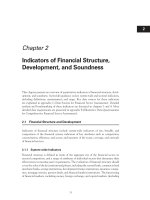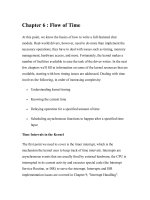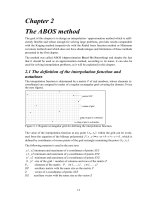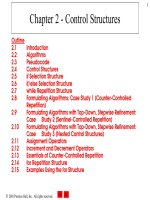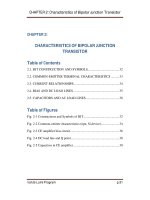Chapter 2 Flow of Control potx
Bạn đang xem bản rút gọn của tài liệu. Xem và tải ngay bản đầy đủ của tài liệu tại đây (837.03 KB, 42 trang )
Chapter 2
Flow of Control
Copyright © 2006 Pearson Addison-
Wesley. All rights reserved.
2-2
Learning Objectives
♦
Boolean Expressions
♦
Building, Evaluating & Precedence Rules
♦
Branching Mechanisms
♦
if-else
♦
switch
♦
Nesting if-else
♦
Loops
♦
While, do-while, for
♦
Nesting loops
Copyright © 2006 Pearson Addison-
Wesley. All rights reserved.
2-3
Boolean Expressions:
Display 2.1 Comparison Operators
♦
Logical Operators
♦
Logical AND (&&)
♦
Logical OR (||)
Copyright © 2006 Pearson Addison-
Wesley. All rights reserved.
2-4
Evaluating Boolean Expressions
♦
Data type bool
♦
Returns true or false
♦
true, false are predefined library consts
♦
Truth tables
♦
Display 2.2 next slide
Copyright © 2006 Pearson Addison-
Wesley. All rights reserved.
2-5
Evaluating Boolean Expressions:
Display 2.2 Truth Tables
Copyright © 2006 Pearson Addison-
Wesley. All rights reserved.
2-6
Display 2.3
Precedence of Operators (1 of 4)
Copyright © 2006 Pearson Addison-
Wesley. All rights reserved.
2-7
Display 2.3
Precedence of Operators (2 of 4)
Copyright © 2006 Pearson Addison-
Wesley. All rights reserved.
2-8
Display 2.3
Precedence of Operators (3 of 4)
Copyright © 2006 Pearson Addison-
Wesley. All rights reserved.
2-9
Display 2.3
Precedence of Operators (4 of 4)
Copyright © 2006 Pearson Addison-
Wesley. All rights reserved.
2-10
Precedence Examples
♦
Arithmetic before logical
♦
x + 1 > 2 || x + 1 < -3 means:
♦
(x + 1) > 2 || (x + 1) < -3
♦
Short-circuit evaluation
♦
(x >= 0) && (y > 1)
♦
Be careful with increment operators!
♦
(x > 1) && (y++)
♦
Integers as boolean values
♦
All non-zero values true
♦
Zero value false
Copyright © 2006 Pearson Addison-
Wesley. All rights reserved.
2-11
Branching Mechanisms
♦
if-else statements
♦
Choice of two alternate statements based
on condition expression
♦
Example:
if (hrs > 40)
grossPay = rate*40 + 1.5*rate*(hrs-40);
else
grossPay = rate*hrs;
Copyright © 2006 Pearson Addison-
Wesley. All rights reserved.
2-12
if-else Statement Syntax
♦
Formal syntax:
if (<boolean_expression>)
<yes_statement>
else
<no_statement>
♦
Note each alternative is only
ONE statement!
♦
To have multiple statements execute in
either branch use compound statement
Copyright © 2006 Pearson Addison-
Wesley. All rights reserved.
2-13
Compound/Block Statement
♦
Only "get" one statement per branch
♦
Must use compound statement { }
for multiples
♦
Also called a "block" stmt
♦
Each block should have block statement
♦
Even if just one statement
♦
Enhances readability
Copyright © 2006 Pearson Addison-
Wesley. All rights reserved.
2-14
Compound Statement in Action
♦
Note indenting in this example:
if (myScore > yourScore)
{
cout << "I win!\n";
wager = wager + 100;
}
else
{
cout << "I wish these were golf scores.\n";
wager = 0;
}
Copyright © 2006 Pearson Addison-
Wesley. All rights reserved.
2-15
Common Pitfalls
♦
Operator "=" vs. operator "=="
♦
One means "assignment" (=)
♦
One means "equality" (==)
♦
VERY different in C++!
♦
Example:
if (x = 12) Note operator used!
Do_Something
else
Do_Something_Else
Copyright © 2006 Pearson Addison-
Wesley. All rights reserved.
2-16
The Optional else
♦
else clause is optional
♦
If, in the false branch (else), you want "nothing" to
happen, leave it out
♦
Example:
if (sales >= minimum)
salary = salary + bonus;
cout << "Salary = %" << salary;
♦
Note: nothing to do for false condition, so there is
no else clause!
♦
Execution continues with cout statement
Copyright © 2006 Pearson Addison-
Wesley. All rights reserved.
2-17
Nested Statements
♦
if-else statements contain smaller statements
♦
Compound or simple statements (we’ve seen)
♦
Can also contain any statement at all, including
another if-else stmt!
♦
Example:
if (speed > 55)
if (speed > 80)
cout << "You’re really speeding!";
else
cout << "You’re speeding.";
♦
Note proper indenting!
Copyright © 2006 Pearson Addison-
Wesley. All rights reserved.
2-18
Multiway if-else: Display, page 63
♦
Not new, just different indenting
♦
Avoids "excessive" indenting
♦
Syntax:
Copyright © 2006 Pearson Addison-
Wesley. All rights reserved.
2-19
Multiway if-else Example:
Display, page 63
Copyright © 2006 Pearson Addison-
Wesley. All rights reserved.
2-20
The switch Statement
♦
A new stmt for controlling
multiple branches
♦
Uses controlling expression which returns
bool data type (true or false)
♦
Syntax:
♦
Display page 62 next slide
Copyright © 2006 Pearson Addison-
Wesley. All rights reserved.
2-21
switch Statement Syntax:
Display, page 64
Copyright © 2006 Pearson Addison-
Wesley. All rights reserved.
2-22
The switch Statement in Action:
Display, page 64
Copyright © 2006 Pearson Addison-
Wesley. All rights reserved.
2-23
The switch: multiple case labels
♦
Execution "falls thru" until break
♦
switch provides a "point of entry"
♦
Example:
case "A":
case "a":
cout << "Excellent: you got an "A"!\n";
break;
case "B":
case "b":
cout << "Good: you got a "B"!\n";
break;
♦
Note multiple labels provide same "entry"
Copyright © 2006 Pearson Addison-
Wesley. All rights reserved.
2-24
switch Pitfalls/Tip
♦
Forgetting the break;
♦
No compiler error
♦
Execution simply "falls thru" other cases
until break;
♦
Biggest use: MENUs
♦
Provides clearer "big-picture" view
♦
Shows menu structure effectively
♦
Each branch is one menu choice
Copyright © 2006 Pearson Addison-
Wesley. All rights reserved.
2-25
switch Menu Example
♦
Switch stmt "perfect" for menus:
switch (response)
{
case "1":
// Execute menu option 1
break;
case "2":
// Execute menu option 2
break;
case 3":
// Execute menu option 3
break;
default:
cout << "Please enter valid response.";
}

